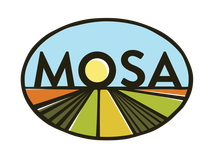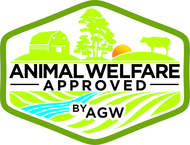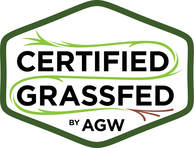 In 2022 we were approached to participate in a research study called the Bionutrient Institute Study spearheaded by Dr. Stephan van Vliet from Utah State University. The requirement was to send 3 ribeye steaks, from different animals at our farm, forage samples, fecal samples, soil samples, and fill out a very extensive questionnaire. The study is the most extensive study that has been done about the differences between grass fed/grass finished beef and grain fed beef. It will dive into the correlations between soil health, gut microbiome, feed and forage quality, beef nutritional content, and human health. As a health coach and someone passionate about nutrition, health, and of course, our farm’s integrity, this is very interesting and exciting to me! The study has a target of 750 steaks from 200 farms and ranches from around the world, and 150 from supermarket shelves. The majority is from North America, but they also include samples from Europe, Australia, and South America. The study has evolved and grown to capture absolute values (an upgrade from the original plan of capturing comparative data). Geeking alert! but, it has added panels for terpenes, minerals, amino acids, and proteomics. Because of these additions, not all results are in and they are distributing to us as they go. Recently, fatty acids results came in. While we were not super surprised, as we expected some of these to come favorable, we were excited to see it on paper! There were 31 markers on the Fatty Acids category (some I didn’t even know existed!) and we came favorable in all, even when comparing the average in our steaks to the average of ALL grass finished steaks, but significantly favorable compared to grain fed steaks. Here are the results of the most recognizable and important amino acids, including THE most important measure, the Omega 6:3 ratio: SNF Avg Grass Fed Grain Fed Alpha Linoleic Acid 1.56 1.10 0.29 EPA 0.42 0.35 0.12 DHA 0.21 0.13 0.12 CLA 0.60 0.47 0.32 TOTAL Omega 6s 3.32 3.63 4.28 TOTAL Omega 3s 2.57 2.08 0.75 Omega 6/3 Ratio 1.29 2.13 7.22 Modern American diets, (mainly because of ultra processed foods) typically boast an omega-6 to omega-3 ratio around 10 to 1, sometimes as high as 30 to 1 while the optimal ratio for health is 4 to 1, so we are way better than this optimal measure! For reference, while some omega 6s are beneficial, too much is not good. Because our diet is so abundant in these (mainly in the form of vegetable oils) and not as abundant in the omega 3s, the ratios are usually off balance. This is why we want to pick food that has less omega 6s and more omega 3s, as our beef show above. The data found that when cows graze a wider diversity of plants on pasture, this correlated directly with the critical omega 6:3 ratio. Basically, greater diversity = more omega-3 fatty acids. We are proud and of course excited to see this! a direct result of our farming practices of good soil health, plant diversity, rotational grazing, and proper grass management.
0 Comments
As a former futures broker, I still read the financial news and I can’t get over how much money (and I’m talking about Trillion with a capital T!) is flowing into climate change technologies.
In a market-based system, you can invest in climate change tech ideas with the possibility to make (or lose) money. There are even contests run by billionaires on the best ideas for drawing down carbon from the atmosphere. Electric cars, solar power, wind turbines are all now mainstream energy production as well as ways we can slow the warming of the planet. However, on the agriculture side we have lagged behind other sectors in the economy. Some newer agriculture inventions or “ideas” to draw down carbon span from absorbing methane through burp masks for cows to precision agriculture and small rocks that can absorb carbon from the air. My intuition and experience tells me most of these ventures will fail. I have a technology that I believe will beat all these inventions. Are you listening Elon Musk and Bill Gates? Here is the Shark Tank “investment”! Every living creature (humans included) produces CO2 via respiration. Cows produce methane from the burping of their digestive system. They are one of the few animals, called ruminants, which have a superpower of turning a non-digestible plant (grass), into protein (milk, meat). Humans produce methane too with their waste (excretions and wastes that go into landfills), but it’s much easier for humans to point fingers than for cows to point hoofs! And cows get a bad rap. But back to the investment point! UW-Madison recently published a paper comparing 3 different cropping systems: 1. Corn and Soybeans, tilling the field and no cover crop 2. Corn and Soybeans, no till and using a cover crop 3. Managed Grazing cows on pasture They found that a managed grazing pasture system (or a different way of managing a cow) showed a carbon capture of 5.3 tons of CO2 per acre per year. All you need for this system to work is grass, cows and proper management. The result is a reduction in CO2 emissions and the production of healthy meat and milk with the byproduct of methane (as cows burp while converting grass to protein). The paper is here should you want to learn about various farming systems and how much carbon they produce. It’s quite an interesting read! Research from UC-Davis shows that a cow produces 220 lbs of methane in a year. Stick with me here as we do some basic math… 1 cow = 220 lbs. of methane / year Methane is 28 times more potent than CO2. 220 lbs. of methane x 28 = 6,160 lbs. of CO2 equivalent. 6,160 lbs. of CO2 / 2000 (1 ton) = 3.08 tons of CO2 a year produced by the cow from the production of meat and milk. Earlier we gave the UW-Madison findings of the pasture system, which captures 5.3 tons of CO2 per year per acre. If one cow emits 3.08 tons per year, the result is a net capture of 2.22 tons of carbon per year/per cow/per acre. 5.3 tons of capture - 3.08 emissions = 2.22 tons of carbon capture At our farm, the numbers may be even better. We have 120 acres grazed with 60 cows (30 cows, 30 yearlings +30 calves). A yearling + a calf = 1 cow in weight. 120 acres / 60 cows = 2 acres per cow. Therefore, our capture is roughly 2x the capture of 1 cow per 1 acre which comes to 4.44 tons of carbon capture per acre. You hear that Elon and Bill?! Now that’s a carbon capture machine that can be replicated AND it produces food for humans as a bonus! Wall Street won’t find this technology sexy because the rural grazing community controls it, and let's face it, there's no money in it for them! But what’s not sexy about higher omega 3’s, greater nutritional density, biodiversity, and water quality? I'll take this carbon capture machine over any system out there, bet on it! Written by: Paul Maggio Harvest season is officially over and happy customers are now enjoying their grass fed beef (and pastured pork, too!) We could not be happier with our finishing weights this year. They finished beautifully, and many, surprisingly quick!
Let us explain what finishing means. Finishing is that last "fattening up" of the cattle to be ready for harvest. Grain fed cattle are actually fed hay (most of them in a feedlot or barn) or some may even be on grass for the beginning of their lives, and then are fed grain the last 3-6 months of life to "fatten up". If you buy meat at the store that is labeled "Grass fed" it most likely means that they were fed grass at some point in their lives, usually at the beginning, but most likely it was finished with grain. Yes... that's what the "Grass fed" label means. Which is why you always want to make sure it says "Grass Finished" or "100% grass fed", or better yet, know and ask your farmer! if what you want is pure grass fed, and no grains. Grain finishing allows for cows to fatten up quickly and easily; it is pretty foolproof. I mean, if you eat cookies and cupcakes for 3 months, you'll see how you will too! Of course, we've already discussed the health benefits of grassfed, vs. grain fed in this blog post. Finishing cattle on grass takes a meticulous and different approach than grain finishing. Grass finishing takes longer, good grass/pasture management, pasture (plant) diversity, and proper rotational grazing. In addition to these practices, we also have a cow/calf operation, meaning our cows have their calves here, on our land, and the calves stay with their mommas, nursing for up to 10 months when they wean to rest before calving again. That is very different to many farms who buy the "stockers" (young calves) from somewhere else and grow them until harvest in their land. We honestly believe the extended nursing makes a big difference in how fast and how well they finish. We now have been farming full time for 7 years, and our first momma cows arrived at the farm almost 9 years ago. We have been fine tuning the herd for good genetics for years now, without bringing any outside animals, and we feel like it has helped with a healthier, stronger herd. Last year we had a great calving season and an excellent harvest season, which is proving that the good grass management, attention to soil heath, daily rotational grazing, ensuring plant diversity and fertility in our pastures- all the best regenerative farming practices- are working its way to excellent results for our customers! 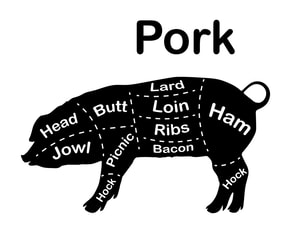 In the 7 years we have been either buying a side of pork or growing our own (the last 3 years) I have learned a lot about what we eat and use, what to ask for, how to package it and other "intricacies" of the cutting instructions process. I must admit I never really researched any of this, and if you do, it can be a bit confusing as there are different names for the same cuts and an infinity of ways to cut the animal! Hopefully this makes it simple and helpful, and if you have questions at the end, please leave a comment with your questions or contact us directly by email. We are here to help! I will lay this out by “part of the animal”, as this is how the processor will be asking for your instructions. LOIN & RIBS This is the area between the shoulder (also called butt... I know- what?) and back legs (also called ham) and is the leanest, most tender part of the animal. Rib and loin chops are cut from this area, as are pork loin roasts and tenderloin roasts. Being the leanest, these cuts will be dry if overcooked, so these are your “quickest” cook cuts. Loin: While this is pretty straight forward, the choice matters because you can either get…
BUT, if you get bone-in pork chops, you CANNOT get Baby back ribs or tenderloin! Ribs:
P.S. We typically like our chops be cut 1″ thick, but if you like them thicker/thinner, please request. Cooking notes: Baby Back Ribs: Baby back ribs are cut from the section of the rib cage closest to the backbone. They are much leaner than spareribs, which is why they need special attention to keep from drying out on the grill! Tenderloin Roast: This lean, delicate, boneless roast cooks very quickly because it’s so small, usually weighing just about 1 pound. Since there is very little marbling, this roast (which is equivalent to beef tenderloin) cannot be overcooked without ruining its texture. BUTT/SHOULDER This is the upper portion of the shoulder (called the blade shoulder) and these cuts are well marbled with fat and contain a lot of connective tissue, making them ideal candidates for slow-cooking methods like braising, stewing, or barbecuing.
Pork Shoulder Roast: It is rich in fat and connective tissue. Alternate Names: Shoulder arm picnic, picnic shoulder, fresh picnic, picnic roast Best Cooking Methods: Grill roasting, barbecuing, roasting, braising. Pork Butt Roast: This large, flavorful cut can weigh between 6-10lbs when they are “bone in”. Alternate Names: Boston shoulder, pork butt, Boston butt Best Cooking Methods: Slow roasting, barbecuing, stewing, braising If this sounds like too much, remember that the meat contains a great deal of fat, which will render out during cooking. Also note that if you have a great deal of meat left over, you can typically freeze the leftovers, but you can also ask the butcher to cut the roasts smaller (3-4lbs?) Pork steaks are taken from the shoulder area of the pig and are usually thicker and tougher than pork chops. Pork steaks are very versatile and can be cooked via sautéing, grilling or braising. Be careful not to overcook the Pork Steaks (especially when cut thin) or they will become dry and tough. Reach 145F, and remove from heat. The meat will be slightly pink, juicy, tender and delicious! Recipes for pork steaks: https://wholelottayum.com/pork-steak-recipes/ BELLY This is the fattiest part of the animal; the underside and the source of your bacon!
LEG (or Hams) Is the rump and rear leg and the source of your hams
Again, these are bone in. While boneless ham is convenient, we find the bone-in variety to be far superior in terms of taste and texture. On a whole hog you get 2 hams. Keep in mind, a whole ham on a hog can weigh between 12 and 25 pounds, so unless you have a really big family for that Easter dinner, consider asking for half hams, maybe some cured, some fresh, or half ham and half ham steaks. Cooking notes: Fresh ham is delicious slow cooked/roasted! I’ve become a big fan as I don’t love cured ham and definitely good with just one quarter cured ham for a holiday. I prefer the fresh ham for the rest of my hams! HOCKS The lower part of the leg
Cooking notes: These have become a favorite at our house for a ham/bean soup! The marrow and natural juices are released from the hocks as they cook, giving liquid-based dishes a flavor and richness that can’t be duplicated by commercially prepared ingredients. I absolutely LOVE this soup with ham hocks, and I add kale or cabbage to it- yum! JOWL These are the cheeks of the animal
We LOVE this Pasta Carbonara recipe! PORK TRIM Is any extra, unwanted portions that will be ground.
OFFAL These may include liver, kidneys, heart, skin, fat, and soup bones
Please see attached current cutting sheet for Wilson Farm Meats to get familiar with what you'd like to ask for. Questions? Make comment below, or email us directly! You've read the headlines. "Processed meats may cause cancer." Nitrates were listed by the WHO as a carcinogenic in 2015. So... should we be eating them? (and should WE be selling them?)
First, let's define processed meats. Processed meats are meats that have been preserved by smoking or salting, curing or adding chemical preservatives. These are your bacon, deli meats/cold cuts, hot dogs, jerky, pepperoni, snack sticks, and all those delicious hams and sausages in your charcuterie board. Curing meat has been a process that's been around for thousands of years... literally paintings in Sicily put the start of curing meats as far back as 40,00 BC. Curing meat is a process that removes moisture from the meat through osmosis which in turn draws out potentially harmful bacteria. Most processes call for a mixture of salt and natural or synthetically derived nitrates that work to regulate moisture loss and preserve qualities such as color, flavor, and longevity. Nitrates and nitrites are actually compounds that occur naturally in the human body and some foods, such as vegetables. Nitrates and nitrites can convert to either nitric oxide (which is beneficial to the body) or nitrosamines (which can be harmful). To convert to nitrosamines, a source of amines, chemicals related to ammonia that are found abundantly in protein foods, is required. Nitrosamines can also be created directly in foods through high-heat cooking, as with fried bacon. In studying the research of the carcinogenic claims, I realize that once again, all the studies to date are observational studies, which cannot prove causation, but correlation- linking only the one food (in this case nitrates/nitrites) in your entire diet and lifestyle to a certain disease. And while there are studies that counter the position, nonetheless, the results have been fairly consistent in their results. However, as with everything, dose makes the poison. While high levels of nitrates can cause harm, these are very difficult levels to reach in one sitting, and very unlikely to happen from food itself. Some argue that a higher cause of concern is high levels of nitrate in water as a result of runoff or leakage from fertilized soil, wastewater, landfills, animal feedlots, septic systems, or urban drainage. It’s also important to keep the cancer risk in context. While the International Agency for Research on Cancer categorises processed meat a carcinogen, the risk is quite small. In the UK, for example, six out of 100 people will get bowel cancer in their lives. Of those who eat 50 grams processed meat (about three slices of bacon) daily, the chance is seven out of 100. Also, a diet high in antioxidants, like Vitamin C and certain other vitamins, can reduce the conversion of nitrates and nitrites to nitrosamines. So what you eat with your cured meats, matter. The other side of processed meats is "what else is in them?"- fillers, "natural" and artificial flavors and coloring, and other chemical preservatives are in many of the commercial ones. This is why we decided to make our own processed meats. While I am all about good nutrition and healthy eating, I'm also about MODERATION and BEST quality of food. Our hot dogs and beef sticks, for example, only use natural preservatives found in celery and cherry juice, and/or lactic acid. Made only with our grassfed beef, and spices, it's all 100% natural and has NO colors, fillers, or artificial anything. There is also much less preservatives in our cured meats, which is why we recommend to keep refrigerated or frozen until ready to eat, because they will spoil faster! So, relax friends, enjoy that occasional charcuterie, delicious grilled hot dog with sauerkraut on top, or snack on that Starry Nights beef stick. Just don't forget a nice big salad on the side! 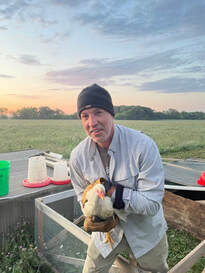 Well, it’s Fall and that’s a wrap on our pastured chicken season! Our newest venture on the farm, and something that customers have asked for years, this summer we finally felt established enough with the beef cows and pigs (and house construction/moving) to get it going. It was a lot of work and we had some learning curves, but it went very well and we are very happy with our product! Whenever we start a new venture we go back to “why” we are doing it, and to our mission statement and values to guide us on “how” to do it. There are many ways to raise chickens and many decisions to make in farming, but with our core values in mind:
we decided Certified Organic and Pastured was the way to go. So, what does that mean? and how exactly do we raise them? We get our chicks at one day old from a local Wisconsin hatchery and bring them straight to one of our small barns that was converted into the chicken brooder. Here the chicks grow under warming lights until they are old enough to regulate their own body temperature. Once they grow feathers, around 4 weeks, they can do so and are ready go outside! On pasture, they live in 2 chicken tractors that Paul and his cousin built (based on Joel Salatin’s designs book) and that are all around protected from predators. Paul moves the chicken tractors, manually, EVERY day- where they have fresh grass and bugs to eat, fresh air, and plenty of room to roam. We feed a certified organic poultry grain mix, also from a local, Wisconsin, organic mill. We put out fresh water daily with organic apple cider vinegar to help protect the chickens from bacteria or viruses. At around 8-10 weeks, we bring the chickens to get processed at a family owned, USDA organic processor, also here in Wisconsin. We pick them up 1-2 days later and at this point, they are ready to go to your homes! 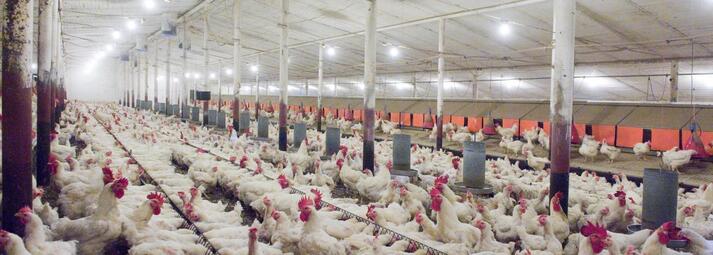 How does this compare to conventional, factory farmed chicken? Factory farm chickens are your good old, very inexpensive chicken at the supermarket. I’ve seen them for as low as $.99/lb, and a whole, already cooked, rotisserie chicken at Costco will cost you merely $5!! But what’s behind this incredible “deal”?
What about “Free Range Chickens”? Now, you might think this is better because they are “free to roam” but this is one of those labels that big ag probably negotiated with the USDA to approve for their marketing purposes. It means very little, but it sounds good. The requirement here is to “have access” to outside part time- but it is very loosely regulated and inspected. A free range bird could easily be one that spends most of its time inside a barn with hundreds or thousands of other bird friends—there may be a door to the outside, but there's no guarantee that your bird will ever venture out there, or that there's even much grass or soil to be found if it does. There is no requirement for these birds to spend ANY time outside; just to have “access”. and Certified Organic chicken? Let’s begin by stating the fact that most "organic chicken" in the supermarket is owned by two big producers, Tyson or Purdue. There are three requirements with organic that make them slightly better, sure:
However, the last one is where I see a bit of a problem. Conventional chickens require around 0.78 to 0.85 square feet per bird, while organic chicken requires 0.85 square feet per bird, which is really not that different! While access to the outdoors and fresh air is part of the organic standards for chickens, it is widely known that the USDA hasn’t really enforced this, and again, access to outdoors could be a concrete slab. It also doesn’t specify how much time they must be allowed to spend outside or how much space they should be given. Organic feed is another downside. It is well known that organic chicken feed at factory farms is many times imported from China. Our organic, pastured chickens also have significant health benefits when compared to conventional chickens. You have the obvious benefits of organic- NO antibiotics ever, NO pesticides, no herbicides or any kind of chemicals in their feed or our land. And NO GMO feed. But pasture-raised chicken also contains 50% more vitamin A compared to conventionally raised chicken. (This nutrient plays an important role in supporting good vision, cell division and growth, a strong immune system, and skin health.) Also, in a 2008 study published in the journal “Poultry Science”, Portuguese researchers discovered that pasture-raised chicken have significantly higher amounts of omega-3 fatty acids than chickens that do not have access to fresh forage. Lastly, while standard poultry feed is supplemented with small amounts of vitamin E, it doesn't come close to the bounty of vitamin E that chickens get from fresh pasture. And this vitamin E gets passed on to you, the consumer! And as we mentioned earlier, you are also at a much lower risk of contracting foodborne illnesses with our pastured poultry than with factory farmed chicken. Besides the health and animal welfare differences between factory farm and pastured chickens, the environmental differences are HUGE, and something that should be considered by all. Factory farms or CAFOs are known for the large amounts of toxic byproducts they generate, which are dumped or leach into the local ecosystem. One company, Tyson Foods Inc., released 104.4 million pounds of pollutants into waterways between 2010 and 2014. In contrast, our pastured chickens, improve our soil by fertilizing our land with their manure deposits. The bedding from our brooding barn goes directly into compost, also used as a natural fertilizer for our land. By supporting organic, pasture-raised poultry, you can help reduce pollution that is currently devastating the environment. Support Local When you buy our chickens, you are not only supporting a healthier and more humane treatment of these animals, you are also supporting your local economy through our family farm, a local hatchery, a local feed mill, and a local processor. I hope this post helps shed some light on how we raise our chickens, how it compares to others, and why we do what we do. And as always, please let us know your feedback, questions, or comments- we love to hear from you! In honor of Earth Day today, and knowing how controversial and misunderstood this topic can be, we figured we write about it from our own knowledge, research, and experience.
When we bought the farm 9 years ago and decided to farm it ourselves- we were told beef cattle was the "easiest", given the fact that we didn't live at the farm. Vegetables are way too labor intensive, dairy needs twice daily milking, chickens need many eyes from predators, so after talking to a few farmer friends and mentors, beef cattle was the best fit for us. But there was also another reason. These farmers- advocates of grass fed- insisted that this was the best option for improving our soil (it was depleted from continuous row crops) and if we really wanted to be environmentally friendly, we needed animals in the fields. I couldn't believe my ears! Being in nutrition and getting bombarded by vegan propaganda that says it is not only wrong to kill an animal to eat it but that this is destroying the planet, we went on a little research of our own to make sure our farming mentors were right. Of course they were right. After much study from Joel Salatin, Judith Shwartz and her fabulous book "Cows Save the Planet", Nicolette Hahn (a longtime vegetarian turned rancher) on "Defending Beef: The Case for Sustainable Meat production", Allan Savory, Wendell Berry, and many others, we were convinced. Let me explain. For decades the public has long been led to believe that livestock, especially cattle, erode soils, pollute air and water, damage riparian areas, and decimate wildlife populations. But is it so clear cut?? Not so, as Allan Savory explains in his TED Talk, “We were once just as certain that the world was flat. We were wrong then, and we are wrong again.” You may think it unlikely that these pastured grazers are the soil saviors we need, but it’s true. Through holistic management and planned grazing, cows can help rebuild soil and restore land to its rightful state; improving carbon sequestration, natural water cycles, and soil fertility and nutrient density. Small Grass-fed Farms vs. Factory Farms Properly managed livestock play an essential role in maintaining grassland ecosystems by functioning as surrogates for herds of wild ruminants that once covered the globe. Hahn Niman argues that dispersed, grass-fed, small-scale farms can and should become the basis for American food production, replacing the factory farms that harm animals and the environment. We need to take a more holistic perspective that puts the soil and its rich microbial life at the heart of our dynamic global ecosystem. Sequestering carbon into the soil holds huge potential as a means of mitigating climate change and increasing soil fertility, and some bold statements have been made about it. It’s important to remember that healthy soil holds far more carbon than unhealthy soil. In the last century, half of most of the world’s soils have been depleted of carbon by 50% to 70%. It’s not holding on to nearly as much carbon as it had and a lot of that has to do with land management. Soil is a living thing. A lot of its living organisms are killed off by all the things we’ve been pouring on the land as part of our industrial agricultural system to make it "more productive"– nitrogen fertilizer, herbicides and pesticides, and fungicides – that in the long term, don't do much for our soil, and that’s beginning to show in decreasing productivity. What we need is more small grazing farms, and more healthy soil. The Role of Cows in Building and Healing the Soil This is where cows come in. Building soil is a top down activity where the myriad microbial life around a plant’s root system in healthy soil feeds the subsoil farther down turning it into topsoil. Cows and livestock can speed up this transformation, if well managed, because they are key contributors to the microbial world (think of all that poop!.). Through systems like Allan Savory's holistic management, What is Holistic Management? When moved in large herds according to a planned (yet, observational at times) schedule, livestock will nibble plants just enough to stimulate plant and root growth, trample the ground in a way that breaks apart caked earth to allow dormant seeds to germinate and water to seep in, and leave dung and urine to fertilize the soil with organic matter (aka carbon). You move them to the next pasture and that land rests and rebuilds. The result is a wide variety of grasses and other deep-rooted plants and rich, aerated soil that acts like a great big sponge so as to minimize runoff and erosion. There are a number of other innovative land management techniques that focus on caring for the content of the soil and working to preserve its innate health, and this is what we practice at Starry Nights Farm. Climate change and global warming are topics we hear in an almost daily basis. Some of us feel it more than others. Fires, hurricanes, droughts, heavy storms, floods, and other weather events are changing our planet. The hard truth is, we talk about "saving the planet", but in my opinion, Earth is resilient- it will adjust and continue on. Humanity on the other hand, is at peril. We can no longer keep up with it and need to reverse our damaging actions. At Starry Nights Farm, we are privileged and proud to be working towards saving our future generations. Caring for the land that feeds and house us is part of our mission, and we are grateful to YOU for caring, supporting us, and being a part of this mission. Happy Earth Day! Finishing in Fall/Winter.
This is our 9th year since buying the farm and our 6th year in operations. Every year we improve, learn, and do things better. For the last few years we have been able to narrow our calving season between April- June and our harvest season late Fall/early winter. This year we have a few harvest dates in November, most in December, and some more will be in January/February 2022 (we are only opening 2021 for now). With this in mind, we have (successfully) been working to extend our grazing season to mid December. It's been nice to see our December harvest finish in fresh grass! When grazing season is over though, we have been separating our finishers from the rest of the herd to give them a different quality feed. Our best, high carbohydrate feed goes to them (also an "all you can eat buffet"!) and we have been very successful at finishing these animals in the early winter months on grass and our best quality hay. Choose Your Processor. We use 2 processors for our beef and pork- Lake Geneva Country Meats and Wilson Farm Meats. We have good relationships with both and have been very happy with their work and service to our customers. However, we know some of you prefer one and others prefer the other, for different reasons, so we now have a "drop down" menu to select the harvest date AND processor. Keep in mind! you need to add 2-3 weeks to that harvest date to figure out when your beef will actually be ready! Request a Size. When we harvest, we usually bring 2 or more animals at a time. While we make sure our animals are well finished for processing, some animals are just genetically bigger than others. Some customers have smaller families and want less beef, and others want more, so this year we would like for you to notify us in our COMMENTS box when making your reservation if you want BIG or SMALL. When the processor gives us the hanging weights we can then try to accommodate our customers preference for more or less beef. If you have bought from us in the past, you can even let us know if you were satisfied with your last amount or want more/less. I can look back at the hanging weight you had and go from there. While this is not a guarantee, it will help us better assign harvested animals to customers based on their needs. It also may be that you are ordering a half instead of a quarter but want a "small half" so you are not overwhelmed by too much beef. Pricing Changes (Tier-pricing). We've been selling in bulk now for about 6 years with the same pricing. Unfortunately, everything else has gone up! This year, we needed to slightly increase the price per hanging weight pound, but decided to now offer "tier pricing". What this means is that if you buy a whole beef you get the same old price of $4.95/lb, for a half side beef $5.25/lb, and for a quarter side $5.50/lb. Of course, you can get creative and economical by buying with a friend, family member, or neighbor, but we request we only deal with one person for payment and communication and the processor will also get the cutting instructions from this one person, even if you are dividing it with others, so please arrange accordingly! That's it! We will work hard in the coming months to use the best grazing management for healthy grasses, healthy soil, and best finishing for our animals. Thank you for your continued support! I may disappoint you with this, but I won’t be citing a bunch of research studies in this post. You can Google away and find 100 research studies supporting plant-based diets as best, and another 100 saying meat is no harm to human health.
I will, however, give you my takeaway from having studied this topic extensively for the last 10+ years- through nutrition school, books, research studies, articles, doctors, scientists, podcasts, documentaries, personal experience, customers… you name it! Before I even talk about the headlines and the studies, I want to state 3 things about meat I feel very confident about after all my research and studies.
My belief is quality over quantity. I absolutely agree that many of us should be eating less meat and more plants (and yes, that would still be a “plant-based” diet!). Consider this:
But what about all those recent headlines saying a vegan diet is best for our health? First of all, how many of us are reading beyond the news article? or worse, the headline? or even worse, the social media post or meme?!?! When you dig in, you find there’s a few issues many scientists and doctors have found with nutritional studies, especially in the plant-based vs meat studies. #1- Funding I’ll start with this basic issue, and unfortunately, this is not limited to nutritional studies. Who is funding the study you are reading? There are many studies these days funded by corporations and private entities with a profit agenda in play, and this, of course, will skew results. The Vegan Foods and now Lab Meats market is growing rapidly! Think of it- with climate change concerns, exposure to the atrocities of CAFOs, and more regulation on them to farm cleaner, it is becoming more expensive for these big companies to produce cheap meat, so they are getting ahead of the game! Fake Meats as the future! They are way cheaper to produce (and definitely cleaner than CAFOs!). , and because they are perceived as “healthy” foods they can charge a premium. Win-win! #2- Observational Studies and the Healthy-user bias When people read about a research study, we have to pay attention to how the study was designed to understand the quality of the findings. Randomized controlled trials (RCTs) are considered the gold standard for clinical research. They have a high impact on clinical guidelines and on healthcare in general, but these are extremely difficult to produce and rare in food and dietary studies. The majority of nutritional research studies are what’s called Observational studies. These are ones where researchers look at a certain group of people and try to draw inferences from their behavior about associations with a disease. These studies are considered low quality research studies. Observational studies were actually never meant to prove a hypothesis, they were meant to generate a hypothesis! The tool used to collect data in observational studies is often a questionnaire, which is extremely weak since people’s memory is not precise and accurate when it comes to what we eat, and we tend to underreport calories and foods consumed. The other problem with nutritional studies is something called “the healthy user bias”. On the topic of plant based vs. meat, observational studies don’t consider anything else in the diet or furthermore, in lifestyle! It is meat vs. no meat. In general, the majority of vegans and vegetarians #1- eat more fruits and vegetables #2 shop at health food stores and #3 have a healthier lifestyle when compared with the GENERAL meat eater. And this is my beef with that! Not all meat eaters are the same. For example, there’s a huge body of plant based supportive studies that have studied Seventh Day Adventists, but SDAs overall diets and lifestyle are healthier. It is part of their religion! So yes, compared to the fast-food eating, smoker, drinker omnivore, hands down plant-based diet will give you a better result. On the other token, studies have shown that, because red meat has been perceived as “unhealthy” for so many years, people who eat more red meat are more likely to smoke, be physically inactive, and eat fewer fruits and vegetables. So, one of the inevitable results of the healthy-user bias is that many observational studies end up comparing two groups of people that are not at all similar, and this casts doubt on the findings. Correlation vs. causation. #3- A Reductionist Approach This doesn’t only apply to research studies, but also to the way we are viewing diets in general and even medicine. Philosopher Gyorgy Scrinis came up with the term “nutritionism,” which he defines as: “the reductive approach of understanding food only in terms of nutrients, food components, or biomarkers—like saturated fats, calories, glycemic index—abstracted out of the context of foods, diets, and bodily processes.” In other words, it’s a focus on the quantity of certain foods (like red meat) or macronutrients (like fat or carbohydrate), rather than the quality of the overall diet pattern. This has led some prominent epidemiologists like Stanford professor John Ioannidis to heavily criticize observational nutrition research. In a famous paper called “Why Most Published Research Findings Are False,” Ioannidis points out that “claimed research findings may often be simply accurate measures of the prevailing bias.” Now, besides most of the studies been flawed, here are some issues I find with vegan diets, especially. Is it elitist? Some critics of vegan diets state that the diet is “elitist” as it requires monitoring of nutrient levels, expensive supplementation, and of course, to be a healthy vegan and even vegetarian diet it has to be done properly. Many doctors and Hollywood celebrities’ proponents of the diet have the ability to afford all this testing, supplementation, and healthy eating (heck, some have personal chefs cooking for them!) but when it comes to feeding the general population, meat will provide much more nutrition for the buck than that of plants + supplements + medical monitoring. Supplementation Needs. When studying nutrition, I remember there was always a caveat with plant-based diets- you may need supplementation. Some nutrients are just not at all available (or too small in amounts) in plants, period. A vegetarian diet does have the advantage of allowing animal products like dairy and eggs, but vegan diets definitely need supplementation. We also always learned the best diet is one found in foods, not supplements. I am not against supplements, these can be very helpful, especially in therapeutic use, but if we are healthy and are eating high quality whole (unprocessed) foods, we shouldn’t need an ongoing daily vitamin to be healthy. To me, it just isn’t natural. My Conclusion? What to do? Unfortunately, there is no short answer and no “one size fits all” when it comes to eating meat or not. I don’t believe in “either/or’s” and don’t think this reductionist approach of eliminating certain foods or macronutrients is good. Having said that, there are extremes in the pendulum of how much meat we need. For the general population, I know we need to eat less of it and when we do, it has to be better quality. However, I know from experience, that some people need more meat and some less. Its just in our nature, genetics, and health conditions. I see it in my own children. Kids are not conditioned to eating a certain way yet, so it is fascinating to observe their cravings. Our oldest daughter needs, craves, and loves meat, where my youngest is happy with oatmeal, yogurt and would honestly live on bread and dairy if I let her! Paul needs more carbs than I do. I need and thrive with more meat. So our pendulums are different, even in one’s family members. I also have customers with specific health conditions that thrive with more meat than plants. At least 5 of them are prior vegans or vegetarians that due to health issues have had to switch back to meat, others with Lyme disease or anemia, and others with autoimmune conditions. Are you called to or want to try vegan? I say go for it! Try it out! Many people don’t crave or need meat at all, or very, very little of it. I would suggest though, to do it with some professional help- be it by at dietician, nutritionist, or “nutritionally trained” doctor that can guide you and monitor your nutrient levels. There are well documented health risks to vegan diets that we shouldn't ignore- like anemia, increased risk of depression and anxiety, inhibition of zinc absorption, and overconsumption of carbohydrates leading to fatty liver and blood sugar deregulation, so you do have to be careful to be able to get all your needed nutrients. So, my conclusion in this whole topic is NO- you do not need to eliminate meat and animal products to be healthy. See and feel what works for you, and look at your overall diet. Add more plant foods. Eat better quality food. Exercise regularly. Drink more water. Sleep better, and manage your stress! Thanks for reading! Hope you learned something, and if you wish to leave a question, comment, counter argument, etc... please leave it in our post comments, I'd love to hear from you! Want to dig deeper? Here are a few resources to check out: A good (albeit long) podcast debate between a prominent Vegan cardiologist and a former vegan turned Paleo Functional Medicine practitioner. https://podcastnotes.org/joe-rogan-experience/kresser-kahn/ Red Meat and Cancer: https://www.ncbi.nlm.nih.gov/pubmed/21540747. A 2011 meta-analysis of 34 prospective studies on red meat and colorectal cancer concluded that the available data was insufficient to support an association between red meat intake and colorectal cancer. Red meat and Heart Disease: https://www.ncbi.nlm.nih.gov/pmc/articles/PMC2885952/. This meta-analysis that included more than 1.2 million participants found no association between the consumption of fresh, unprocessed red meat and the risk of coronary heart disease (CHD), stroke, or diabetes. https://www.ncbi.nlm.nih.gov/pubmed/26017245. This meta-analysis of 11 studies concluded that the scientific literature does not support the existence of a relationship between red meat intake and an increased risk of myocardial ischemia. https://www.ncbi.nlm.nih.gov/pubmed/8842068. This study assessed the relationship between dietary habits and mortality in vegetarians and omnivores who frequented health-food stores, based on the premise that health-food store shoppers would be more health-conscious, regardless of whether or not they ate meat. It was found that both vegetarians and health-conscious omnivores live longer than people in the general population and that there was no survival difference between vegetarians and omnivores. https://academic.oup.com/ajcn/article/89/5/1613S/4596950. In this study, vegetarians and their omnivorous friends and family (who were recruited with the assumption that they would be more health conscious than the general population) were followed for five to 10 years. The risk of death for vegetarians/vegans and health-conscious omnivores was 52 percent lower than the risk of death for the general population. There was no difference in mortality between vegetarians and omnivores. Chang-Claude J, Hermann S, Eilber U, Steindorf K. Lifestyle determinants and mortality in German vegetarians and health-conscious persons: results of a 21-year follow-up. Cancer Epidemiol Biomarkers Prev. 2005; 14(4):963–968. http://cebp.aacrjournals.org/content/14/4/963.long. The Heidelberg Study in Germany compared lifespan in health-conscious omnivores with vegetarians (a total of 2,000 participants). The risk of death for both vegetarians/vegans and omnivores was 59 percent lower than the risk of death for the general population. They found no difference in mortality between vegetarians and omnivores. The study found that a high level of physical activity was the greatest predictor of lifespan—independently of whether meat was consumed. https://www.sciencedirect.com/science/article/pii/S016752731401290X. A meta-analysis of studies comparing mortality in vegetarians/vegans and omnivores found no mortality benefit for vegetarians/vegans. It also concluded that any previous observed benefits were driven by Seventh Day Adventist studies, which are plagued with confounding variables. "Health risk factors associated with meat, fruit and vegetable consumption in cohort studies: A comprehensive meta-analysis." Long, but interesting. Read last paragraph of "Discussions".  It is no secret there is a giant diet trend on becoming Vegan. The movement has been gaining force for a few years now, strengthening in the last couple years with the IPO of Beyond Meat and introduction of plant-based burgers to fast food restaurants. The big reasons supporters claim for the movement are #1 it is better for your health, #2 it is better for the environment, and #3 to protect animals, or animal welfare. As a nutritionist and health coach, and of course a beef farmer, I get the question a lot, and I figured I would answer to the best of my knowledge and based on my experience. I confess I have been trying to write this post for months, getting overwhelmed, and realizing that regardless of how “simplistic” a headline or article might make it seem, the topic is extremely complex. For that reason, I am dividing this topic into 3 posts. Today I’ll start with my personal background and story, in a few weeks I will write about “the science and nutritional research”, and in April, just in time for Earth Day, I will write about “a vegan diet for the environment”. Please NOTE: I am by NO means against a vegan diet for whatever reason you would do it. There is enough divisiveness in our world today and I see one developing in the plant based vs. omnivore discussions, but I truly believe there shouldn’t be! We can all listen and learn from each other. We all have reasons why we make our choices, and this is why I start this topic explaining my personal background and experience. So let’s dive in… My Personal Story Yoga and “ahimsa” After a few years of working in the corporate world as a CPA in accounting and finance in my 20’s, I became interested in yoga and trained for a number of years. I eventually left the corporate world and became a teacher and manager at a yoga studio in downtown Chicago. During that time, all my yogi friends were vegetarian. I also learned one of the important principles of yoga- ahimsa- “respect for all living things and avoidance of violence toward any sentient being”. So of course I quickly dropped meat and joined the club! A month+ into it, I did not feel good. There were no amount of beans, eggs, cheese, avocados, and nuts that would fulfill me. I was low energy, always hungry, weak, jittery, cold, etc.. but I was determined. Desperate for answers on what to do, I talked to my beloved yoga teacher- a 70+ year old vegetarian and Hindu man from southern India, and explained my dilemma of wanting to be vegetarian but not being able to feel good. We had a long conversation, but his message was: “So you are harming yourself so you don’t harm the animals? Eat the meat!” Oh my God! I got the blessing, but I admit it didn’t come without shame that I couldn’t make it work. Fertility Struggles Around that time Paul and I were ready to have kids! But fertility was not on my side. I couldn’t get pregnant and when I did, I miscarried. I wasn’t ready to get into IVF, needles and doctors visits, so I decided to pursue some natural ways. I went to a wonderful holistic center for fertility where I received nutrition consults, acupuncture and Chinese herbs. This was my first experience with a nutritionist. After looking at what I was eating (and even though I was back on meat, I always tried limiting it) she recommended two things: full fat dairy and more meat. WHAT? This went against everything I thought I knew about nutrition! After all, don’t the headlines say fat and meat are bad? Well, "it is not that simple", she explained. Long story short… it helped. I became pregnant and had a healthy pregnancy and birth. And today I know for certain that she was right, it is not that simple. My Nutrition Studies This experience sparked my curiosity and fascination on how food can have such a profound effect on our health and how little we actually know about it. Pregnant with Cecilia I went on to study nutrition at the Nutrition Therapy Institute in Denver, CO. I learned a lot about biology, biochemistry, the function of the different nutrients in our bodies, etc. but I still felt like I didn’t know how to actually work with clients, which is when I later pursued my Health Coaching certification through the Institute for Integrative Nutrition. The principle of their program is “There is no ONE diet for everyone- each body is different and we should eat differently". Wow! What a revelation that was! Drinking more water and eating more fruits and vegetables is good for everyone, right? But even that is simplistic. Some of us should eat a little less fruit, others cannot tolerate beans, and some vegetables are actually not good for some. They taught us to work with our clients to figure out what is the best diet for them, by helping them use their own experience, observation, and of course, looking at their genetics and health conditions. Health Coaching During my work as a health coach, it was fascinating to see how some of my clients actually would thrive with less meat, and others, like me, needed it. Some didn’t tolerate dairy so well, and for others, it is beneficial. Meat, gluten, starches, sugar, fat, the timing of food, fasting, frequent eating- these ALL depend on YOUR biology. It was a great experience to work with clients "one on one" and discover together what worked for them- regardless of what they thought was "good or bad for you". Farming Through selling our organic, grass fed beef, we have been lucky to meet customers from all walks of life and that purchase our beef for different reasons- some for environmental concerns, others for better animal welfare, and many and most for health reasons. Most people have heard that grass fed beef is better for you than grain fed beef, but we’ve also had customers with Lyme disease and autoimmune diseases whose digestive systems are so fragile they may not tolerate legumes or other plant sources of protein or whose doctors have recommended grass fed and pastured meats for its valuable nutrients. We have some anemic customers whose doctors were informed enough about nutrition (and most aren't!) to encourage them to eat beef liver and more grass fed and pastured meats. We even have a former vegan who couldn’t do it anymore for health reasons but always wants to make sure her meat is of good quality and that the animals are living a good life while at the farm. It has been incredibly humbling and rewarding for us to be able to nourish, and even heal, so many people in our community with food we produce. While I don’t work as a health coach anymore because we decided to focus as a family on our farm business, I still love nutrition and continue to read, listen, discuss and learn about food as medicine and the powerful ways you can prevent (and even heal) disease naturally. In the next post I will dive into what I have learned about the science of plant based diet and omnivore diet, and the nutritional studies around it. I hope you stayed tuned, and thanks for reading along! |
AuthorMarisa usually writes about nutrition, grass fed beef, organic agriculture, as well as sharing delicious recipes; Paul writes about farm work- sharing his stories and experiences, and most times... we both collaborate on the stories! Archives
March 2024
Categories
All
|
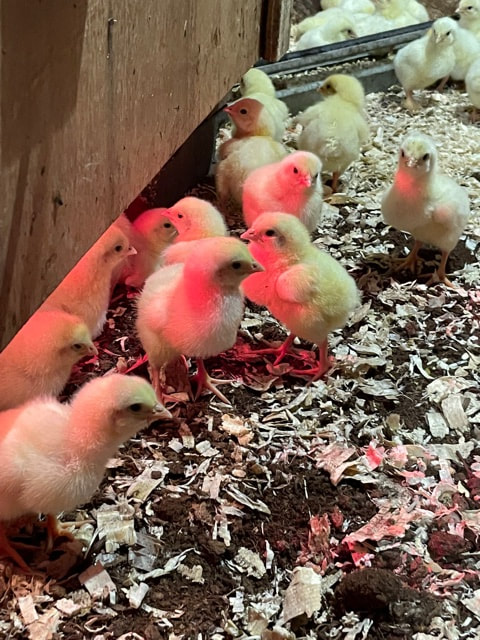
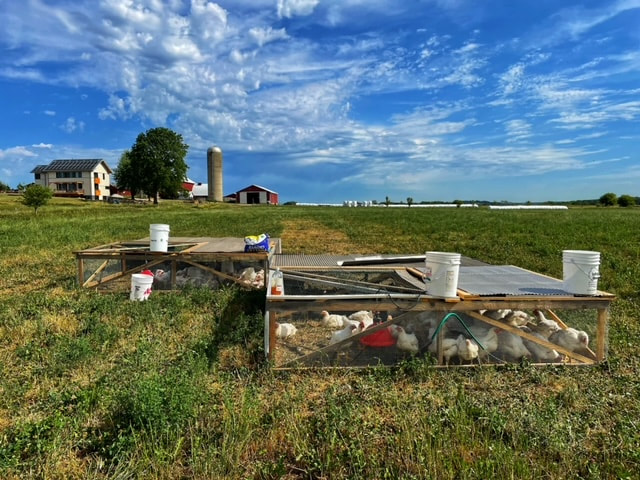
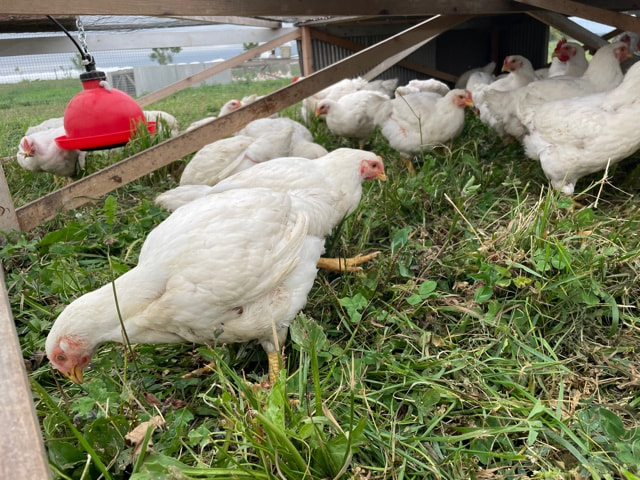
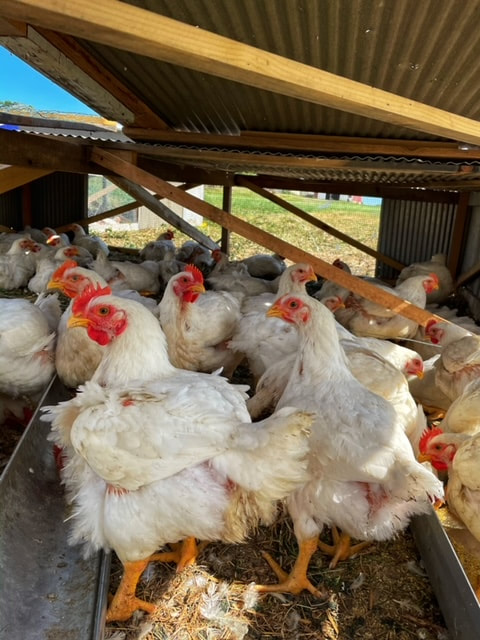
 RSS Feed
RSS Feed
